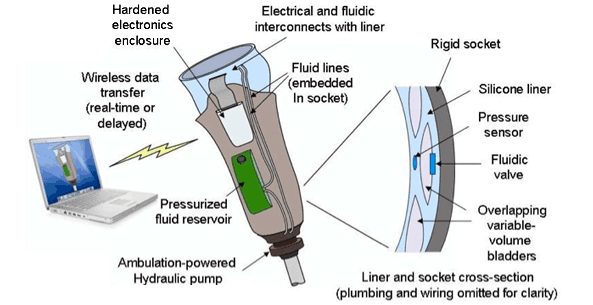
Challenge
A prosthetic socket is the interface between an amputee’s residual limb and a prosthetic limb. Unlike the tissues under the foot, the soft tissues of the residual limb aren’t well adapted to tolerate weight-bearing loads. Prosthetists are tasked with creating a comfortable, custom interface for the amputee that appropriately distributes pressures across the socket surface. Some pressure must be applied everywhere to avoid blistering but local high pressure points should be avoided, with special care taken to limit pressure on load-intolerant regions, such as bony areas. Exacerbating these challenges is the fact that the volume and shape of the residual limb change over time. The limb often shrinks over the course of the day as interstitial fluid is pumped out while the amputee walks. Longer-term changes due to weight gain/loss and muscle atrophy are also common.
Need
Current approaches to residual limb volume management are crude and inconvenient. Most commonly, amputees will remove the socket and don socks on the residual limb to accommodate lost volume. This approach results in a global volume adjustment, which does not accurately reflect the non-uniform nature of the limb shape change. A more intelligent and convenient approach is needed to meet the needs of active amputees, who are more likely to lose limb volume quickly.
Technical Challenges
A practical solution to limb volume management must be simple for both the amputee and prosthetist to use. It should require little or no special fitting, donning/doffing procedures or maintenance. The size and weight of the system should also not dominate the prosthetic device.
Solution
We are developing a dynamic prosthetic socket system that monitors and adjusts to limb volume changes. The Dynamic Socket consists of an elastomeric liner (similar in geometry and material properties to what most amputees currently wear) with embedded sensing elements and fluidic bladders and channels. The sensors monitor the socket fit continuously and compare to a baseline established by the prosthetist. As the fit deviates from the baseline, incompressible fluid (liquid) is moved into or out of bladders to reach the desired fit.
Features/Benefits
- Can chronically monitor socket fit
- Intelligent volume adjustments based on sensor readings
- Both global and local adjustments
- Uses ubiquitous socket fitting procedure, requiring minimal extra procedures
Applications
The Dynamic Socket is targeted primarily to lower-limb amputees who experience large volume fluctuations. Active amputees, such as injured soldiers, are of primary interest as the high activity levels often result in larger volume loss throughout the day. These amputees also require a higher-performance fit. The technology is also applicable to vascular disease amputees who lack sensitivity on the residual limb and have unique tissue-health concerns.
Technology Transfer and/or Collaboration Opportunities
We are open to collaborations with clinical or commercial partners relating to this technology. For more information, please contact us.